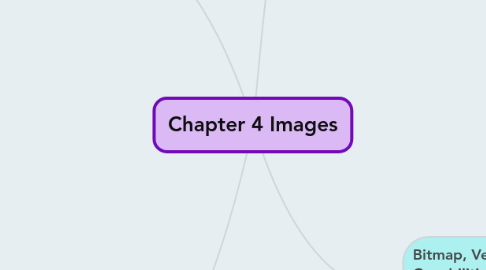
1. The use of colors and palettes in multimedia
1.1. Understanding natural light and color
1.1.1. -Light comes from an atom where an electron passes from a higher to a lower energy level. -Each atom produces uniquely specific colors. -Color is the frequency of a light wave within the narrow band of the electromagnetic spectrum to which the human eye responds.
1.1.2. -Additive color -Subtractive color -Color models
1.1.2.1. Addictive color -In the additive color method, a color is created by combining colored light sources in three primary colors - red, green, and blue (RGB). -TV and computer monitors use this method.
1.1.2.2. Subtractive color -In the subtractive color method, color is created by combining colored media such as paints or ink. -The colored media absorb (or subtract) some parts of the color spectrum of light and reflect the others back to the eye -Subtractive color is the process used to create color in printing. -The printed page consists of tiny halftone dots of three primary colors: cyan, magenta, and yellow (CMY).
1.1.2.3. Models used to specify color in computer terms are: -RGB model – A 24-bit methodology: color is specified in terms of red, green, and blue values ranging from 0 to 255. -HSB and HSL models – Color is specified as an angle from 0 to 360 degrees on a color wheel. -Other models include CMYK, CIE, YIQ, YUV, and YCC.
1.2. Color palettes
1.2.1. -Palettes are mathematical tables that define the color of pixels displayed on the screen. -Palettes are called “color lookup tables,” or CLUTs, on the Macintosh. -The most common palettes are 1-, 4-, 8-, 16-, and 24-bits deep
2. Various Image file types used in multimedia
2.1. Macintosh formats
2.1.1. On the Macintosh, the most commonly used format is PICT. PICT is a complicated and versatile format developed by Apple. Almost every image application on the Macintosh can import or export PICT files. In a PICT file, both vector-drawn objects and bitmaps can reside side by side.
2.2. Windows formats
2.2.1. The most commonly used image file format on Windows is DIB, also known as BMP. DIB stands for device-independent bitmaps. Bitmap formats used most often by Windows developers are: BMP - A Windows bitmap file TIFF - Extensively used in DTP packages PCX - Used by MS-DOS paint software
2.3. Cross-platform formats
2.3.1. JPEG, GIF, and PNG – Most commonly used format on the Web Adobe Portable Document Format (PDF) – Manages multimedia content PSD, AI, CDR, DXF – Proprietary formats used by applications Initial Graphics Exchange Standard (IGS or IGES) – Standard for transferring CAD drawings COLLADA 3D – Standard for transferring 3-D files KML (Keyhole Markup Language) and KMZ (a zipped package of KML files and images) – XML text-based formats used by Google for mapping
3. Workout a graphical scheme by planning your approach, organizing tools, and configuring computer workspace
3.1. Before commencing the creation of images in multimedia, you should: 1.Plan your approach : Outline project and graphics ideas first – Make a flowcharts and storyboards. 2.Organize the available tools : Most authoring systems provide the tools with which can create the graphic objects of multimedia directly on screen. 3.Configure computer workspace: Have multiple monitors, if possible, for lots of screen real estate (viewing area)
4. Bitmap, Vector and 3-D images – Capabilities and Limitation of all three
4.1. Bitmap
4.1.1. Bitmap editor called painting program
4.1.2. A bitmap is a data matrix that describes the characteristics of all the pixels making up an image
4.1.3. Bitmapped images can have varying bit and color depths.
4.1.4. A bitmap is made up of individual dots or picture elements known as pixels or pels.
4.1.5. Bitmapped images can have varying bit and color depths.
4.1.6. Bitmaps are an image format suited for creation of: -Photo-realistic images -Complex drawings requiring fine detail
4.1.7. Where do bitmaps come from
4.1.7.1. Capture a bitmap using a camera.
4.1.7.2. Capture a bitmap from a photo or other artwork using a scanner to digitize the image.
4.1.7.3. Make a bitmap from scratch with a paint or drawing program
4.1.7.4. Grab a bitmap from an active computer screen with a screen capture program, then paste it into a paint program or your applications
4.1.8. Bitmap Software
4.1.8.1. Adobe’s Photoshop and Illustrator
4.1.8.2. Corel’s Painter and CorelDraw
4.2. Vector
4.2.1. vector editors are called drawing program.
4.2.2. Vector-drawn images are used in the following areas:
4.2.2.1. Computer-aided design (CAD) programs needed by architects and engineers
4.2.2.2. Graphic artists designing for the print media
4.2.2.3. 3-D animation programs – changes of position, rotation, and shading of light Applications requiring drawing of graphic shapes
4.2.3. How vector-drawn images work
4.2.3.1. A vector is a line that is described by the location of its two endpoints.
4.2.3.2. Vector drawing makes use of Cartesian coordinates.
4.2.3.3. Cartesian coordinates are numbers that describe a point in two- or three-dimensional space as the intersection of the X, Y, and Z axes.
4.3. Vector-drawn images versus bitmaps -Vector images use less memory space and have a smaller file size as compared to bitmaps. -For the Web, pages that use vector graphics in plug-ins download faster and, when used for animation, draw faster than bitmaps. -Vector objects are easily scalable without loss of resolution or image quality. -Resizing a bitmapped image requires either duplicating pixels, while vector image, a rescaled image retains the quality of the original. -Vector images cannot be used for photorealistic images. -Vector images require a plug-in for web-based display. -Bitmaps are not easily scalable and resizable. -Bitmaps can be converted to vector images using autotracing.
4.4. 3D Drawing
4.4.1. 3D Drawing tools -Daz3D -Form*Z -NewTek′s Lightwave -Autodesk’s Maya -Trimble’s SketchUp
4.4.2. Features of a 3-D application -Modeling - Placing all the elements into 3-D space. -Extrusion - The shape of a plane surface extends some distance. -Lathing - A profile of the shape is rotated around a defined axis
